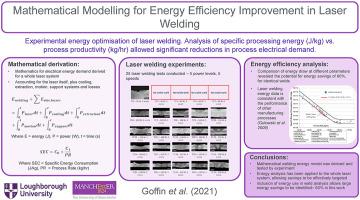Journal of Cleaner Production ( IF 9.7 ) Pub Date : 2021-09-18 , DOI: 10.1016/j.jclepro.2021.129012 Nicholas Goffin 1 , Lewis C.R. Jones 1 , John Tyrer 1 , Jinglei Ouyang 2 , Paul Mativenga 2 , Elliot Woolley 1

|
Within the global manufacturing industry, there is increasing recognition of the need to improve energy efficiency, to reduce both costs and carbon footprint. Significant work has sought to improve the energy efficiency of a variety of different processes, but in the case of laser welding, research has primarily focussed on the laser-material interaction and not on energy rationalisation. This work addresses this knowledge gap by methodically investigating and analysing the energy requirements of a laser welding process. In this study, a mathematical model has been created in order to take a “whole-system” approach to laser welding electrical demand, accounting for all component sub-systems of the laser cell. This model was then experimentally tested via use of an electrical energy monitor to gather energy data for an autogenous welding process carried out on 316L stainless steel at a variety of parameters. Mathematical analysis of this data was then used to create a matrix of electrical power draws at different test conditions, which was further developed into an analysis of process productivity. This revealed a very strong non-linear inverse correlation between process rate (kg/hr) and specific energy consumption (J/kg). This process productivity measurement was placed in context with other manufacturing processes, revealing that laser welding has a relatively high process rate (1E-02 – 1E0 kg/hr), and relatively low energy consumption (1E+08 and 1E+09 J/kg) in comparison. A further benefit of this model is that it allows the selection of processing parameters according to their energy demand. Energy flow analysis allows the direct comparison of the energy demand of different sets of processing parameters, which metallurgical analysis shows produce similar welds. In this study, it was shown that parameter selection alone was capable of producing an electrical energy saving of 60% for a given weld. This emphasises the importance of parameter selection and control in enabling environmentally cleaner manufacturing without compromising part quality or the need for investment in capital equipment.
中文翻译:

提高激光焊接能效的数学建模
在全球制造业中,人们越来越认识到需要提高能源效率,以降低成本和碳足迹。大量工作试图提高各种不同工艺的能源效率,但在激光焊接的情况下,研究主要集中在激光与材料的相互作用上,而不是能量合理化上。这项工作通过有条不紊地调查和分析激光焊接过程的能量需求来解决这一知识差距。在这项研究中,创建了一个数学模型,以便对激光焊接电气需求采取“全系统”方法,考虑到激光单元的所有组件子系统。然后通过使用电能监视器对该模型进行实验测试,以收集在各种参数下在 316L 不锈钢上进行的自熔焊接过程的能量数据。然后使用对这些数据的数学分析来创建不同测试条件下的电力消耗矩阵,该矩阵进一步发展为对过程生产率的分析。这揭示了过程速率 (kg/hr) 和比能量消耗 (J/kg) 之间非常强的非线性逆相关性。该过程生产率测量与其他制造过程相关联,表明激光焊接具有相对较高的过程速率(1E-02 – 1E0 kg/hr)和相对较低的能耗(1E+08 和 1E+09 J/kg ) 相比下。该模型的另一个好处是它允许根据能源需求选择加工参数。能量流分析允许直接比较不同组加工参数的能量需求,冶金分析表明会产生类似的焊缝。在这项研究中,表明对于给定的焊缝,仅选择参数就能够节省 60% 的电能。这强调了参数选择和控制的重要性,可以在不影响零件质量或无需投资资本设备的情况下实现更环保的制造。在这项研究中,表明对于给定的焊缝,仅选择参数就能够节省 60% 的电能。这强调了参数选择和控制的重要性,可以在不影响零件质量或无需投资资本设备的情况下实现更环保的制造。在这项研究中,表明对于给定的焊缝,仅选择参数就能够节省 60% 的电能。这强调了参数选择和控制的重要性,可以在不影响零件质量或无需投资资本设备的情况下实现更环保的制造。











































 京公网安备 11010802027423号
京公网安备 11010802027423号